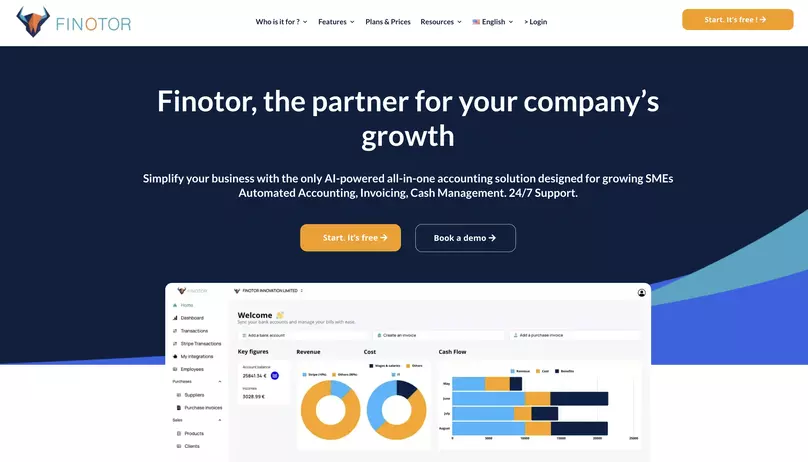Contents
- 1 Understanding the Basics of Financial Statements
- 2 Interpreting Key Financial Ratios
- 3 Advanced Financial Analysis Techniques
- 4 Applying Technology to Financial Management
- 5 Interpreting Key Financial Ratios
- 6 Advanced Financial Analysis Techniques
- 7 Applying Technology to Financial Management
- 8 Applying Technology to Financial Management
Understanding the Basics of Financial Statements
Mastering the art of financial statements is crucial for any business owner or financial professional. Financial statements are the bedrock upon which the financial health and prospects of a company are assessed. At Finotor, we understand the importance of grasping these concepts to manage and automate your company’s accounting and financial tasks seamlessly.
The Balance Sheet: Snapshot of Financial Health
The balance sheet is a fundamental financial statement that provides a snapshot of a company’s financial health at a specific point in time. It lists the company’s assets, liabilities, and shareholders’ equity. Understanding the balance sheet is essential for assessing a company’s net worth and financial stability. Assets must always equal the sum of liabilities and shareholders’ equity, a principle known as the accounting equation. This resource offers detailed guidance on preparing accurate balance sheets.
The Income Statement: Tracking Revenue and Expenses
Also known as the profit and loss statement, the income statement measures a company’s financial performance over a specific accounting period. It records revenues, costs, and expenses to determine the company’s net income or loss. Revenue is the income generated from normal business operations, while expenses include the costs necessary to earn that revenue. The income statement is crucial for tracking profitability and identifying areas for cost reduction and revenue improvement. For a step-by-step guide on preparing an income statement, click here.
The Cash Flow Statement: Monitoring Liquid Assets
The cash flow statement is a report that provides insights into a company’s inflows and outflows of cash and cash equivalents over a period. This statement is instrumental in determining the short-term viability of a company, especially its ability to pay bills and finance operations. It categorizes cash flow into operations, investing, and financing activities. A positive cash flow indicates that a company’s liquid assets are increasing, enabling it to settle debts, reinvest in its business, pay expenses, and provide a buffer against future financial challenges.
Interpreting Key Financial Ratios
Interpreting financial statements involves more than just reviewing numbers; it requires analyzing the relationships between those numbers. Financial ratios are tools that help stakeholders understand financial relationships and the company’s overall performance. They provide critical insights into various aspects of the business, such as its liquidity, profitability, and leverage.
Liquidity Ratios: Assessing Short-term Financial Stability
Liquidity ratios measure a company’s ability to meet its short-term obligations. The most common liquidity ratios include the current ratio and the quick ratio. A higher ratio typically indicates better liquidity and financial health, suggesting that the company can easily cover its immediate liabilities without selling assets at a loss.
Profitability Ratios: Measuring Income Performance
Profitability ratios assess a company’s ability to generate earnings relative to its revenue, assets, equity, and other factors. These ratios, such as the net profit margin, return on assets (ROA), and return on equity (ROE), are vital for investors and creditors to evaluate the company’s income-generating capability and management’s efficiency in utilizing its resources.
Leverage Ratios: Understanding Debt Positions
Leverage ratios indicate the level of a company’s debt relative to its assets or equity. They highlight the financial structure of the business and its ability to meet long-term financial commitments. Common leverage ratios include the debt-to-equity ratio and the debt-to-assets ratio. An optimal level of leverage ensures that a company can leverage borrowed funds to drive growth while maintaining manageable debt levels.
Advanced Financial Analysis Techniques
Beyond basic financial statement analysis, advanced techniques such as vertical and horizontal analysis, cash flow analysis, and predictive analysis using AI and machine learning can provide deeper insights into a company’s financial status and future prospects.
Vertical and Horizontal Analysis: Trend and Proportion Assessment
Vertical analysis assesses each item on a financial statement as a proportion of another item, typically total sales on the income statement or total assets on the balance sheet. Horizontal analysis involves comparing historical financial information over a series of periods to identify trends and growth patterns.
Cash Flow Analysis: A Closer Look at Solvency
Cash flow analysis is a detailed examination of the cash flow statement. It helps to assess a company’s solvency and its ability to generate cash to fund operations, pay debts, and make investments. This analysis is key to understanding the company’s financial viability in the long run.
Using AI and Machine Learning for Predictive Analysis
Advanced technologies like AI and machine learning are revolutionizing the field of financial analysis. Predictive analysis leverages these technologies to forecast future financial outcomes based on historical data. By doing so, companies can make informed decisions, mitigate risks, and identify opportunities for growth. Finotor is at the forefront of integrating these innovations into financial management.
Applying Technology to Financial Management
Modern financial management is increasingly reliant on technology to streamline processes, enhance accuracy, and offer strategic insights. Finotor’s all-in-one solution embodies this integration, offering real-time financial automation and in-depth analytics.
Automating Financial Processes with Finotor
Automation is transforming financial management by reducing manual entry, minimizing errors, and freeing up valuable time for strategic activities. Finotor’s platform utilizes cutting-edge technology to automate various financial processes, ensuring efficiency and accuracy.
Integrating Banking and E-commerce Platforms
Finotor facilitates seamless integration with banking systems and e-commerce platforms like Stripe and WooCommerce, making bank reconciliations and financial management more efficient and interconnected.
Data-Driven Decision Making with Advanced Analytics
In the digital age, data is a valuable asset. Finotor leverages advanced analytics to turn data into actionable insights, empowering businesses to make data-driven decisions and focus on their core activities.
Interpreting Key Financial Ratios
Understanding financial statements is crucial, but interpreting the key financial ratios provides insights that go beyond the surface figures. These ratios are essential indicators of a company’s financial health and can guide strategic decision-making.
Liquidity Ratios: Assessing Short-term Financial Stability
Liquidity ratios are vital for evaluating a company’s ability to pay off its short-term liabilities with its short-term assets. The most common liquidity ratios include the current ratio and the quick ratio. A higher ratio typically indicates better short-term financial health. Companies should aim for a current ratio that reflects industry standards and maintains financial flexibility.
When managing finances with Finotor, businesses can effortlessly track their liquidity ratios, ensuring they have the information needed to maintain operational stability and make informed decisions.
Profitability Ratios: Measuring Income Performance
Profitability ratios like the net profit margin, return on assets (ROA), and return on equity (ROE) measure a company’s ability to generate earnings relative to its revenue, assets, and shareholders’ equity, respectively. These ratios offer insights into how efficiently a company is running and how profitably it is deploying its resources. For more details on how to prepare an income statement, which is crucial for profitability analysis, visit Harvard Business School Online.
Integrating Finotor’s AI-driven analytics helps businesses to not only monitor these ratios in real-time but also to compare them against industry benchmarks, thereby optimizing income performance.
Leverage Ratios: Understanding Debt Positions
Leverage ratios, such as the debt-to-equity ratio and the interest coverage ratio, provide insights into a company’s debt levels and its capacity to meet financial obligations. A balanced approach to leveraging is critical as too much debt can increase financial risk, while too little may hinder growth opportunities.
By leveraging Finotor’s comprehensive financial management tools, businesses can continuously monitor their leverage ratios, ensuring they achieve an optimal balance between debt and growth.
For additional resources on preparing financial business statements, which are foundational for calculating these financial ratios, consider the expert insights available at Wolters Kluwer.
Advanced Financial Analysis Techniques
In the realm of financial management, mastering the art of advanced analysis techniques is critical for making informed decisions and maintaining a competitive edge. These techniques delve deeper into financial statements, uncovering insights that are not immediately apparent.
Vertical and Horizontal Analysis: Trend and Proportion Assessment
Vertical and horizontal analyses are pivotal in examining financial statements over different periods and comparing them to industry benchmarks. Vertical analysis provides a proportional understanding of financial statements by displaying each line item as a percentage of a base figure within the same period. This approach helps in identifying cost structures and determining the relative weight of accounts. Conversely, horizontal analysis looks at the numbers across multiple periods, offering a clear picture of trends, growth patterns, and potential areas of concern.
Cash Flow Analysis: A Closer Look at Solvency
The cash flow statement, an oft-overlooked but significant financial document, sheds light on a company’s liquidity and solvency. Through a thorough cash flow analysis, businesses can track the actual flow of cash within the organization, revealing the quality of earnings as cash flow provides a more unvarnished view of a company’s financial health than earnings alone.
Using AI and Machine Learning for Predictive Analysis
With the advent of AI and machine learning, predictive analysis in finance has reached new heights. These technologies can identify patterns in vast datasets that are beyond human analytical capabilities, enabling businesses to anticipate future trends and make data-driven decisions. Companies like Finotor are at the forefront of integrating AI into financial management, offering tools to not only analyze historical data but also to predict future outcomes, thus enhancing strategic planning.
Applying Technology to Financial Management
Embracing technology is not an option but a necessity in today’s fast-paced business environment. Financial management software has revolutionized how companies handle their financial affairs, offering efficiency and accuracy.
Automating Financial Processes with Finotor
Automation in financial management is about streamlining and simplifying processes. Finotor’s all-in-one solution automates repetitive tasks like transaction categorization, invoice management, and report generation, freeing up valuable time for financial strategists to focus on analysis and decision-making. Moreover, with 24/7 support and real-time analytics, Finotor ensures that businesses are always on top of their financial game.
Integrating Banking and E-commerce Platforms
Integration of financial management systems with banking and e-commerce platforms is another area where technology shines. Finotor seamlessly integrates with systems such as Stripe and WooCommerce, simplifying bank reconciliations and enhancing financial oversight. By linking these platforms, businesses can enjoy a holistic view of their financial status, making it easier to manage cash flow and inventory.
Data-Driven Decision Making with Advanced Analytics
Finally, data-driven decision making is the cornerstone of modern financial strategy. Advanced analytics dig deep into financial data, uncovering insights that can lead to more informed and strategic decisions. With tools from Finotor, businesses can leverage their financial data to its fullest potential, identifying trends and opportunities that may otherwise go unnoticed.
To learn more about preparing accurate financial statements, visit Accounting Tools.
Applying Technology to Financial Management
In the realm of financial mastery, the integration of technology into financial management is no longer an option but a necessity. With the rapid advancements in digital solutions, businesses are looking to leverage these technologies to streamline operations, gain insights, and drive strategic decisions. In this section, we’ll explore how modern tools like Finotor are revolutionizing financial management.
Automating Financial Processes with Finotor
Finotor stands at the forefront of financial technology, providing a comprehensive, all-in-one solution for managing accounting, finance, and banking for businesses. Automation is the key to efficiency, and Finotor utilizes cutting-edge AI and machine learning algorithms to automate tedious financial tasks. By automating processes such as data entry, transaction categorization, and even complex financial reporting, Finotor frees up valuable time for business owners and financial managers to focus on more strategic tasks. This not only speeds up financial processes but also reduces the likelihood of human error, ensuring more accurate financial statements.
Integrating Banking and E-commerce Platforms
Integration capabilities are core to Finotor’s value proposition. By providing seamless connections with banking systems and e-commerce platforms like Stripe and WooCommerce, Finotor simplifies the reconciliation process, ensuring all financial data is synchronized and up-to-date. This integration facilitates a holistic view of a company’s financial health, allowing for more informed decision-making. The ability to link various financial accounts and platforms can significantly reduce the time and effort required to prepare financial statements, thus accelerating financial analysis and reporting.
Data-Driven Decision Making with Advanced Analytics
The power of Finotor extends beyond automation and integration, as it furnishes businesses with robust analytics tools to interpret complex financial data. These tools provide actionable insights that can inform critical business decisions. By analyzing trends and patterns using Finotor’s advanced analytics, businesses can better understand their financial performance and anticipate future outcomes. The ability to harness data for decision making is crucial for staying competitive in today’s market. Finotor’s analytics can reveal opportunities for cost savings, revenue optimization, and investment strategies tailored to the unique financial landscape of each business. For a deep dive into the preparation of financial statements, one can also refer to resources like The Balance Money for additional guidance.
Embracing technology in financial management not only enhances efficiency and accuracy but also empowers businesses to adapt quickly to changing financial landscapes. Finotor exemplifies the transformational potential of digital tools in the financial domain, offering a step-by-step guide for mastering financial statements and driving business success through informed financial strategies.









